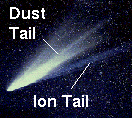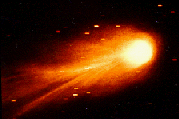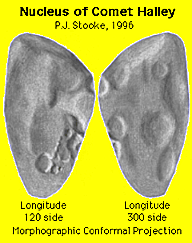General Properties of
Comets
As we have noted in the introduction, the most concise description of comets is
that they are dirty snowballs. They are a few kilometers
across, and appear to mostly be composed of water, carbon dioxide, ammonia, and
methane ices, with dust mixed in. We believe that this composition represents
a sampling of
primordial material from which the Solar System was made.
Therefore, they are of considerable scientific interest for the information
that they may carry concerning the early history of the Solar System.
Cometary Orbits
Comets interact gravitationally with the Sun (and other objects in the Solar
System). Their motion is also influenced to some degree by gases jetting out
of them, so their orbits are primarily but not completely
determined by gravity.
Here is an image showing
7 such jets from
Hale-Bopp, a
recently-discovered, long-period
comet that was very bright comet
in the Spring of 1997.
Most cometary orbits appear to be elliptical, or in some cases
parabolic. The most common comets belong to a population called the
short-period comets that have only mildly elliptical orbits that carry
them out to a region lying from Jupiter to beyond the orbit of Neptune.
A dozen or so of these comets pass
through the inner Solar System each year, but they usually are only seen in
telescopes.
The comets that are more likely to be easily visible are much rarer, and are
thought to come from a great spherical cloud of cometary material surrounding
the Solar System called the Oort Cloud. This sphere is a
light year (50,000 A. U.) in radius, so it is enormous, but the total mass of
cometary material in this cloud is probably less than that of the Earth.
Occasionally a comet in this cloud is disturbed gravitationally, for example by
a passing star, and started on a long elliptical or parabolic orbit toward the
Sun. These long-period comets are primarily responsible for the
brighter comets observed historically. The orbits of both the long-period and
short-period comets may be strongly influenced if they pass near the Jovian
planets, particularly Jupiter itself.
Plotting Your Own Orbits
You may make real-time plots of the orbits and present positions of comets (and
other objects in the Solar System) using the Web-based
Help pages
associated with "Solar System Live" which explains how to obtain
these.
The Head and Coma
The Tail
 The tails of bright comets can be 150 million kilometers (1
A.U.) in length, making them the "largest" objects in the Solar System.
However, the tail is composed of gas and dust emitted from the nucleus and is
very diffuse. The vacuum in the tail is much better than any vacuum we can
produce on Earth.
The tails of bright comets can be 150 million kilometers (1
A.U.) in length, making them the "largest" objects in the Solar System.
However, the tail is composed of gas and dust emitted from the nucleus and is
very diffuse. The vacuum in the tail is much better than any vacuum we can
produce on Earth.
Many comets have two tails, a gas tail (also called
the ion tail) composed of ions blown out of the comet away from the Sun by
the solar wind, and a dust tail composed of dust particles liberated
from the nucleus as the ices are vaporized. The dust particles are left behind
in the comet's orbit, and blown slightly away from the Sun by the pressure of the
light from the Sun.
Thus, they tend to curve relative to the straight ion tail. The ion tail often
shows structure associated with variations in the ejection rate from the
nucleus over time.
The adjacent image of Comet West (1976) illustrates distinct ion and dust
tails
(Ref). As seen in this example, the ion tail and the dust tail usually have different
appearances. The ion tail is typically bluer in color, narrow, and straight; the dust tail is more
diffuse, often looks curved, and is more white in color. These differences in appearance
are directly correlated
with the different sources and compositions of the two tails.



 The tails of bright comets can be 150 million kilometers (1
A.U.) in length, making them the "largest" objects in the Solar System.
However, the tail is composed of gas and dust emitted from the nucleus and is
very diffuse. The vacuum in the tail is much better than any vacuum we can
produce on Earth.
The tails of bright comets can be 150 million kilometers (1
A.U.) in length, making them the "largest" objects in the Solar System.
However, the tail is composed of gas and dust emitted from the nucleus and is
very diffuse. The vacuum in the tail is much better than any vacuum we can
produce on Earth.